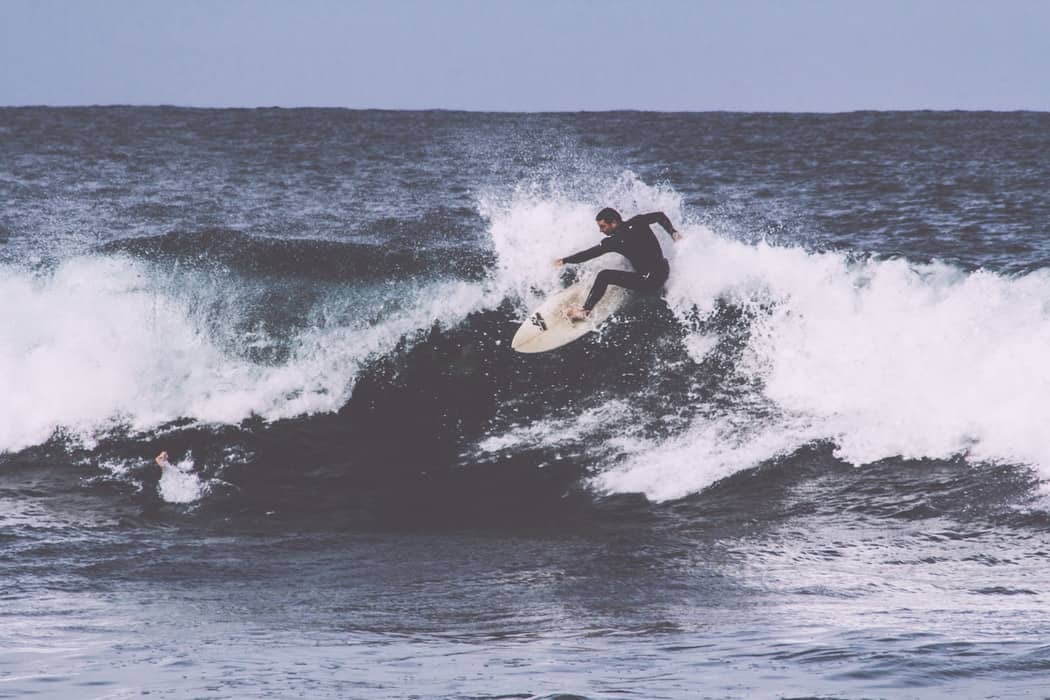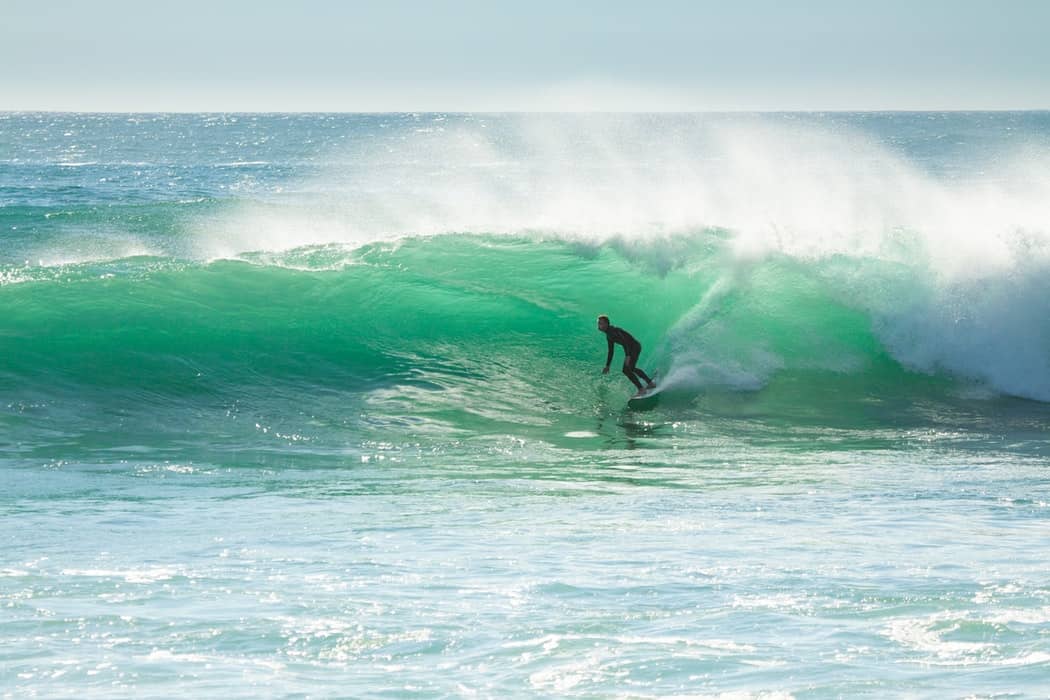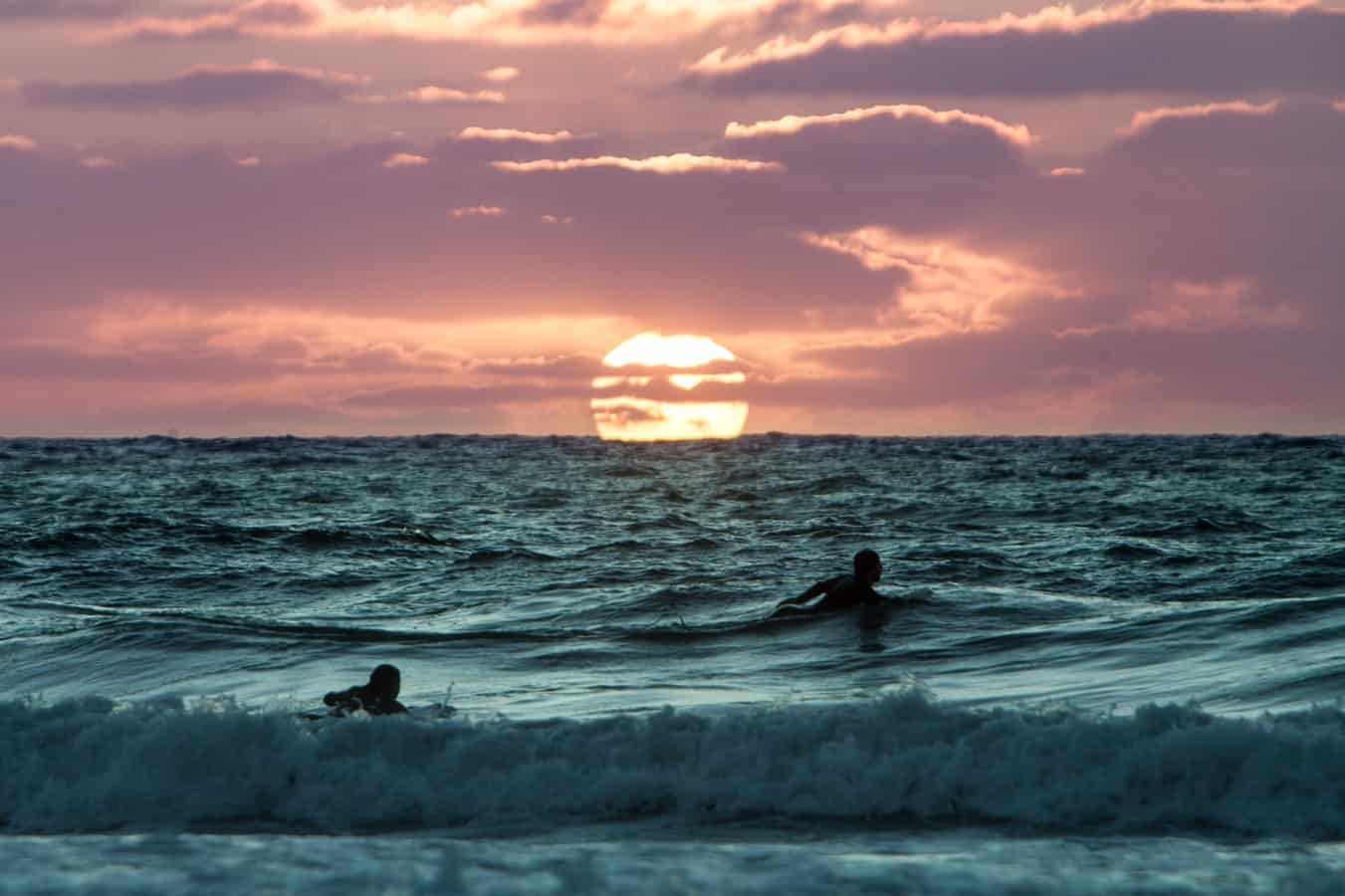So you want to be a surfer. You’ve seen locals at your beach shredding up a storm and you want to experience the same. Patience young grasshopper, the journey is long and doesn’t have the immediate gratification you get from other sports. But it’s worth it. Trust me.
So why is surfing such a difficult sport to learn? Surfing is a difficult sport to learn because of the combination of balance, timing and endurance required to have the smallest amount of success on the water. Unlike other sports, the smallest weakness in your surf technique can ruin what would be a perfect wave. Surfing is a lot of work and provides little gratification when you’re first starting out.
What Muscles Do You Use When Surfing?
When you paddle out, you use muscles in your back, lats, shoulders, arms, and chest. Like swimming, the consistent pulling against the water is the equivalent to using resistance bands in the gym. The way a surfer arches their back builds muscle in the lower back, and neck. Each time a surfer stands up they’re basically doing a push up. Going even further, really talented surfers will build muscle in their core and thighs while they’re on a wave. The constant pumping up and down the wave engages these muscles by contracting and expanding the limbs. Long story short, the more you surf, the more muscles you’re going to need to build. The act of paddling out, popping up and balancing on your board when riding a wave requires conditioned muscles that have been properly trained in muscle memory.
How Important Is Balance In Surfing?
Balance is of paramount importance in surfing; hence why the first lesson you should learn in surfing is how to pop up with proper fitting on the beach. The next thing you need to practice is popping up and balancing on the board as you ride the white water. White water refers to the end of a wave after it’s crashed that you see closer to the beach. This is where even the most spirited beginner surfers meet their maker. The difficulty involved with the timing of popping up and navigating the force of even a small white water wave for the first time is significant. When you’re first starting out it’s going to be a lot of trial and error. What’s important is to make sure your footing is consistent and that you’re getting a little closer to perfect timing each time you paddle into a wave and pop up.

Why Is “Reading The Ocean” Difficult?
The short answer is that the ocean is a cruel mistress that, in many ways, is nearly unpredictable. There are simply too many factors that go into waves to be able to predict what the ocean will do on any given day. One minute the offshore winds are perfect and the surf is glassy, the next, they’re choppy and unsurfable.
But beyond reading surf reports, one of the hardest parts of surfing is knowing when to paddle into wave or rather gauging whether a wave worth dropping into or not. When waves break on the shore they offer opportunities for us to ride them. Every wave is different and offers a different way to ride it. But before you can ride that wave you need to be able to see where you want to go, to see the path you want to surf, to read the ocean.
No matter what level surfer you are, catching the wave and popping up in the right place is the hardest thing in surfing. Once you are standing up on your board on the right part of the wave, surfing is easy. Reading the ocean, choosing the right wave, paddling into the wave at the right entry spot and popping up seamlessly are the hardest parts of surfing. And unfortunately, there’s no trick to learning this timing. You just have to put the time in. Most surfers believe that you need to be surfing for at least a year to get beyond beginner status. Your first year of surfing may be hardest, but every surfer must pay their dues.
Why Is It Harder To Practice Surfing Versus Other Sports?
Like skiing or snowboarding, surfing requires very specific temperatures, gear and most importantly TIME. There is no ease of access when it comes to surfing. You have to wake up early (one of the best times to surf) wax your board and pray that your weekends are filled with glassy waves. You can’t just go to a YMCA or a field to practice like you can with sports like basketball or soccer. So with that, it will inevitably take longer to get the hang of surfing seeing as at best, most can only surf once a weekend or once every other weekend assuming the weather conditions are preferable and they don’t have anything else going on their lives that would take precedence.
Will Learning To Surf Be Easier If I Skate Or Longboard?
Longboarding and surfing both feature long boards. However, the difference in length is significant. The average skate longboard is 41 inches and the average surfboard length is closer to 78 inches. In surfing, you steer with you back foot instead of your front foot like you do in longboarding, but how the board responds is surprisingly similar. In that way it’s actually more similar to snowboarding but the same general rules apply. As an experienced downhill longboarder I found the adjustment to steering with your back foot surprisingly smooth after the first few tries.
Though the materials and makeup of the boards are very different, the fundamentals of balance are extremely similar. The biggest difference is the material each of these boards rides over. Surfers rely on the surfboard’s buoyancy, or ability to float, which comes from its density. The board is less dense than the water underneath it. Longboards on the other hand simply rely on the board to handle the riders weight and wheels to enable forward motion. However the balancing act of a longboard’s “bendy” plywood that allows it to turn or carve is very similar to the heel/toe balance a surfer must perform when balancing on a surfboard.

How Does Comfort With Speed Help With Surfing?
If you’ve longboarded or snowboarded chances are you’re an expert in bombing hills and navigating speed and speed wobbles. Speed wobbles are when your board is moving faster than your legs can handle, causing the board to wobble back in forth, usually ending in a nasty wipeout. As a longboarder or snowboarder becomes more experienced with higher speeds, he or she becomes more comfortable with the speed. This is crucial for surfing becomes one of the first skills a surfer must learn is how to navigate the tremendous speed one can experience when dropping into a sweet wave.
Is A Surf Stance Similar To Other Board Sports?
Like skating or snowboarding, both your feet must be centered on the width of the surfboard. Your feet arches should be positioned equally on each side of the stringer. Not standing up with your feet centered will most likely make you fall on the side on which you put more weight. Like almost every board sport, you have to figure out if you surf goofy or regular.
A “Regular Surfer”, surfs with their left foot forward on the board. A “Goofy Surfer” surf with your right foot forward. Skate stances abide by the exact same terminology. In most cases, surfers ride with their strongest foot (the foot you play with in soccer) at the back of the surfboard. However this isn’t always the case. For instance, I’m right foot dominant in soccer and ride goofy in both longboarding and skateboarding. A trick to figure this out is to have someone push you gently in the back. The first foot you instinctually put forward to stop you from falling will most likely be the one you put forward on the surfboard.
How Does Powersliding Factor Into Surfing?
The ability to powerslide is a skill that directly factors into the surfing skill set. When surfing even small waves in the white water, surfers practice moves that are referred to as Bottom Turns and Cutbacks. A Bottom Turn is when the bottom turn is the most important maneuver in surfing. For many, it represents the foundation of surf riding because it is the first turn on a wave after dropping in, and it allows you to channel the speed and momentum towards the open face ahead of you. The bottom turn is the bottom line. It is where it all begins.
While the motion of doing a Bottom Turn is extremely similar to the motion of powersliding, the Cutback is much more similar in concept. The cutback allows you to reduce the speed with a by taking the surfer back from the shoulder into the pocket of the wave and reposition him in the energy zone. This is almost identical to the “brake” a powerslide activates before continuing down a hill.
Is Surfing The Hardest Sport To Master?
Surfing is one of the most difficult and complex sport in the world. Think about it. Not one wave is the same, so your playground is constantly changing. Elements such as wind, tides and swells are affecting the waves you surf differently every single day.
It’s a very challenging and enjoyable learning process. But once you catch your first green wave, you’ll be hooked. Knowing the learning curve helps you prepare your attitude and expectations towards your surfing. Contrarily to snowboarding, for example, there’s no moment on that third day where you finally feel comfortable and then rarely fall again. In surfing, you will wipeout for years. As a wise surfer once told me, if you’re not falling, you’re not learning.
How Can I Improve My Balance For Surfing?
If you’re wondering if working on your balance for surfing is even possible out of the water, the answer is yes. Many people think that balance is one of those things that you either have or you don’t. How many times have you heard that someone has natural balance? Like everything, natural athleticism will of course help with any kind of sports-related skill, but in reality balance comes down to practice.
Any exercise that increases your core strength will have a positive effect on your overall fitness and your balance. So start with single leg balance. A single leg balance will help you work on strengthening your lower body and improving overall balance. Stand, keeping your feet hip-width apart, and distribute your weight equally between both legs. Shift your weight to the right and lift your left foot off the floor. Hold this position as long as you can, aiming for around 30 seconds. Place your hands on your hips, lift your left leg to the side, and bend your leg back at the knee. Hold this for 30 seconds and then return to the starting position. Repeat on the other side. Do three reps on each side and either increase the reps or the time as you see fit. Too easy? Try it with your eyes closed.
You can also do a single leg balance with a ball toss. Simply do exactly the same exercise but either: throw a tennis ball up in the air and catch it or throw a tennis ball against a wall and catch it Keep your eyes open at all times for this one! This is a common exercise for many sports including basketball and is also a common exercise when recuperating a leg injury through physical therapy.
Is Learning To Surf Worth It?
In case it wasn’t clear by the tone of this article, my answer is a resounding YES. Surfing is one of the most unique experiences you can have and I’ve never felt so connected to nature while doing a sport. In fact, surfing is such a spiritual experience that it even feels weird to call it a sport. I had the unique background of longboarding on land and windsurfing before I ever popped up on a surfboard, so I kind of knew the deal with board sports going into surfing. That is, that the first couple attempts can be ROUGH. Windsurfing broke me in properly, as my first two weeks consisted of falling, falling and then falling some more. Lucky for us, sustaining serious injuries learning to surf is actually far less common in water sports like surfing. So fail all you want! Make baby steps to get better and once you feel comfortable, don’t be afraid to take the leap and paddle into a wave that makes your heart skip a beat. No one gets better at anything by staying in their comfort zone. Go for it and I promise, perfect ride or wipeout you’ll be glad you did it and be that much closer to the next stage of your surf journey. So be safe, but also don’t be afraid to go for it. Happy surfing!


